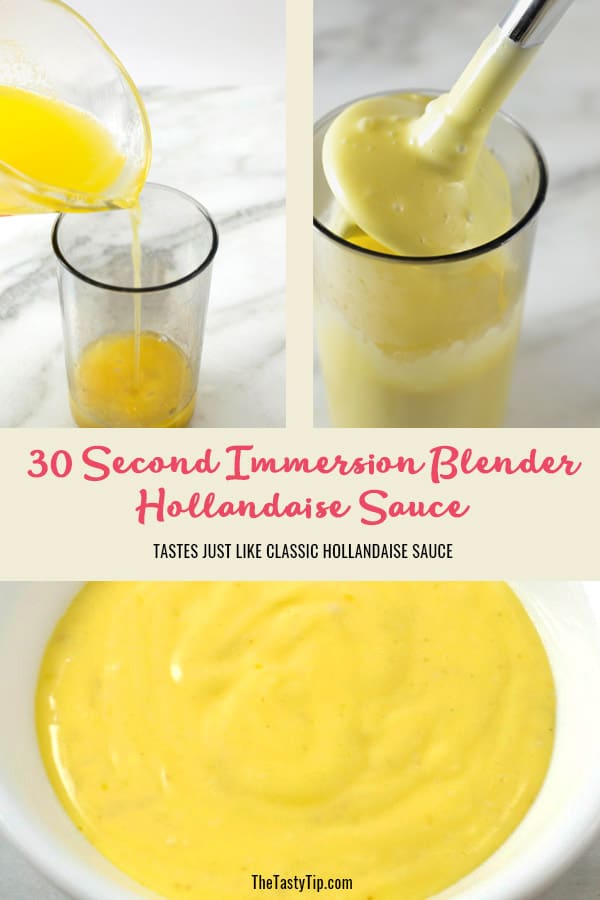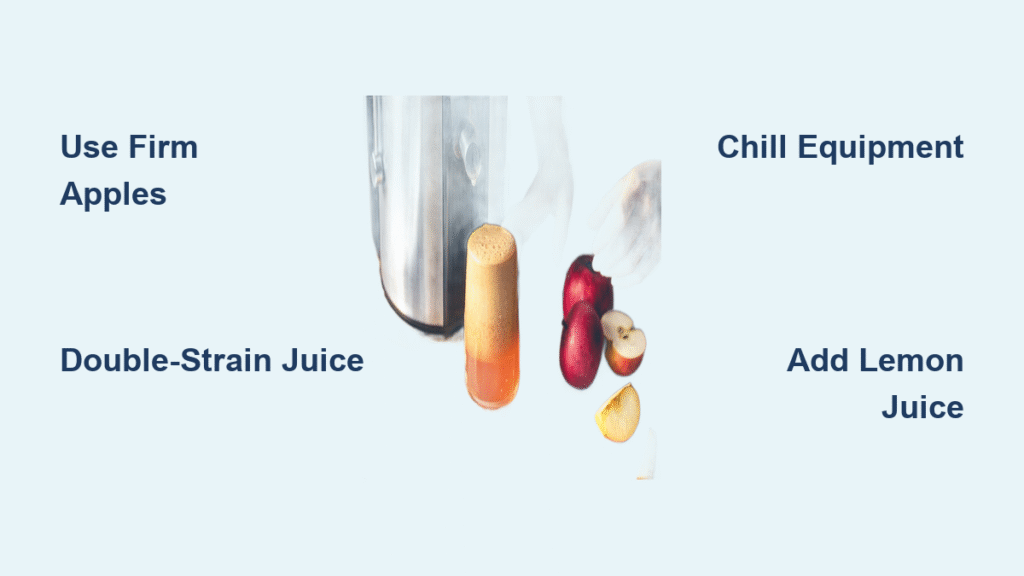Hollandaise sauce doesn’t need to be a brunch-time nightmare. For decades, home cooks have avoided this classic French sauce because the traditional double-boiler method demands constant whisking, precise temperature control, and ends in scrambled eggs more often than silky perfection. But your immersion blender transforms this intimidating process into a 60-second triumph—no special skills required. This foolproof immersion blender hollandaise technique eliminates the narrow temperature window that causes most failures, delivering creamy, buttery results that stay stable for hours. Whether you’re making eggs Benedict at 8 AM or need a last-minute sauce for asparagus, you’ll never fear hollandaise again.
The immersion blender hollandaise method works because high-speed shear forces instantly emulsify near-boiling butter into microscopic droplets suspended in cool egg yolks. Unlike the stovetop version where you pray the sauce doesn’t break, the blender’s vortex simultaneously cooks the eggs to a safe 160°F while creating a rock-solid emulsion. You’ll skip the double boiler entirely and pour hot butter directly into yolks—something traditionalists would consider sacrilege. But this science-backed approach produces restaurant-quality results with near-100% success rates. In this guide, you’ll master the exact temperature thresholds, equipment tricks, and troubleshooting fixes that make immersion blender hollandaise the easiest sauce in your repertoire.
Why Your Immersion Blender Beats Whisking for Hollandaise

Traditional hollandaise relies on slow, manual whisking to suspend butter droplets in egg yolk—a fragile process where temperatures above 160°F scramble the eggs. The immersion blender hollandaise method flips this science completely: hot melted butter (180-185°F) pours directly into cool yolks while the blender’s vortex creates microscopic emulsion droplets in seconds. This high-shear technique generates enough friction heat to safely cook yolks to 160°F without scrambling, eliminating the double boiler’s narrow temperature danger zone.
The blender’s narrow container creates a powerful downward pull that ensures complete incorporation—something impossible with hand whisking. While traditional methods require constant motion for 10-15 minutes, your immersion blender hollandaise finishes in 30-60 seconds with zero risk of breaking. Most importantly, this method produces a thicker, more stable emulsion that holds for hours without refrigeration, making it ideal for busy brunch service.
Critical Temperature Thresholds You Can’t Ignore
Butter must hit 180-185°F—not a degree cooler or hotter. Below 180°F, the sauce won’t thicken properly; above 185°F, yolks scramble instantly. Use an instant-read thermometer: melt butter until foaming subsides (but don’t let it brown), then remove from heat immediately. For room-temperature yolks (70°F), the final sauce hits 160°F—safely pasteurized. Cold fridge yolks (40°F) yield 110°F sauce, which still emulsifies perfectly but requires gentle reheating before serving.
Must-Have Tools for Foolproof Immersion Blender Hollandaise

Your equipment choices make or break the emulsion. A 6-inch immersion blender shaft is non-negotiable—it must reach the container bottom to create the vortex needed for proper emulsification. Pair it with a tall, narrow vessel like a 2-cup glass measuring cup or wide-mouth mason jar. The container diameter should snugly fit your blender head: too wide (like a bowl) loses vortex power; too narrow causes splashing. Always choose glass or plastic—metal containers impart metallic flavors to the delicate sauce.
Essential Tool Checklist
- Immersion blender with minimum 6-inch shaft
- 2-cup glass measuring cup (ideal diameter: 2.5-3 inches)
- Instant-read thermometer (critical for butter temp)
- Small saucepan for melting butter
- Heat-proof pitcher with spout for controlled pouring
Perfect Egg Yolk to Butter Ratio Every Time
Scale your immersion blender hollandaise perfectly with this foolproof ratio: 1 large egg yolk emulsifies exactly ¼ cup (2 oz) of melted butter. This base formula (2 yolks + ½ cup butter) serves two generously. For larger batches, switch to 1 yolk per ⅓ cup butter once exceeding 1 cup total volume. Always use fresh, room-temperature yolks—they emulsify faster and reach safe temperatures quicker. If using cold yolks straight from the fridge, increase butter temperature by 5°F.
Base Recipe for Two Servings
- 2 large egg yolks (room temp preferred)
- ½ cup (1 stick) unsalted butter
- 1 tbsp fresh lemon juice
- 1 tsp warm water (90-110°F)
- Pinch of salt
- Optional: pinch of cayenne or ¼ tsp Dijon mustard
Never omit the warm water—it prevents over-thickening and stabilizes the emulsion. Salted butter works in a pinch, but reduce added salt by half. Clarified butter yields ultra-smooth texture but whole butter (with milk solids) is simpler and equally effective.
Step-by-Step: 60-Second Immersion Blender Hollandaise
Prepare Your Station First
Gather every tool before starting—you won’t have hands free once blending begins. Position your immersion blender in the container with the head flush against the bottom. Pre-measure lemon juice, water, and salt. Have melted butter ready in a heat-proof pitcher with spout.
Execute the Perfect Emulsion
- Combine yolks: Add yolks, lemon juice, warm water, and salt to your narrow container
- Start vortex: Insert blender head to container bottom, turn to high speed
- Pour hot butter: While blending, stream butter down the container side in a pencil-thin line (30-60 seconds)
- Adjust consistency: If too thick, blend in warm water 1 tsp at a time
- Final seasoning: Taste and add salt, lemon juice, or cayenne as needed
Critical tip: Never pause the blender mid-pour. If you must stop, restart blending at the bottom before resuming the butter stream. The sauce should coat the back of a spoon immediately—if runny, your butter was below 180°F.
Fix Runny, Broken, or Grainy Hollandaise Instantly

Sauce Too Thin? Rescue It Now
This means your butter was under 180°F. Fix by blending 1 fresh yolk with ½ tsp water and ½ tsp lemon juice, then slowly drizzle your runny sauce into this new base while blending. For future batches, use a thermometer—don’t guess butter temperature.
Sauce Broken or Curdled? Two Fixes
For minor breaks: Add 1 tbsp cold water or lemon juice and blend 5 seconds. For severe curdling: Start with 1 fresh yolk in the container, blend on high, and slowly drizzle the broken sauce into it. Prevention is key—always pour butter in a thin, steady stream without stopping.
Grainy Texture? Only One Solution
Discard and restart. Graininess means your butter exceeded 185°F, scrambling egg proteins. Next time, remove butter from heat as soon as foaming subsides and verify 180-185°F with a thermometer. This is the most common failure point—don’t skip the thermometer.
4 Restaurant-Style Variations to Master
Béarnaise Sauce for Steak Lovers
Replace lemon juice with 2 tsp white wine-shallot-tarragon reduction (simmer ¼ cup white wine, 2 tbsp shallots, 1 tsp tarragon until reduced by half). Finish with 1 tsp fresh chopped tarragon. Perfect over grilled ribeye.
Blood Orange Maltaise for Vegetables
Substitute lemon juice with 2 tsp fresh blood orange juice and add ½ tsp grated zest. Drizzle over roasted carrots or asparagus—the citrusy twist elevates simple sides.
Brown Butter Hollandaise Upgrade
Brown your butter until nutty and golden (150°F), then cool slightly before using. Creates deep, complex flavor over salmon or chicken. Watch carefully—browning happens fast!
Herb-Infused Hollandaise Shortcut
After emulsifying, blend in 1 tbsp fresh chives, parsley, or dill. For vibrant green sauce, add ½ tsp spinach powder. Ready in 5 extra seconds for stunning presentation.
Safe Storage and Reheating Without Breaking
Your immersion blender hollandaise hits 160°F during preparation—safely pasteurized with no raw egg risk. Store leftovers in an airtight container for up to 3 days. Never freeze—the emulsion shatters upon thawing. Reheat gently: microwave at 50% power in 10-second bursts while stirring, or use a double boiler over barely simmering water. Hold warm for service in a thermos or pre-warmed pot below 140°F for up to 2 hours. If sauce thickens while holding, blend in 1 tsp warm water.
Beyond Eggs Benedict: Unexpected Hollandaise Pairings
Stop limiting immersion blender hollandaise to brunch! This versatile sauce transforms everyday dishes:
- Steamed vegetables: Drizzle over broccoli, green beans, or artichokes for instant elegance
- Grilled salmon: Spoon generously over center-cut fillets (add 1 tsp dill for herb version)
- Breakfast hash: Elevate corned beef or sweet potato hash with a hollandaise flood
- Crab cakes: Replace tartar sauce with lemon-dill hollandaise for restaurant flair
- Roasted mushrooms: Toss creminis in warm hollandaise for luxurious side dish
Pro Brunch Hacks for Flawless Hollandaise Service
Time your immersion blender hollandaise perfectly by preparing components in sequence: cook proteins first (eggs, bacon, salmon), then melt butter while they rest. Keep yolks, lemon juice, and water pre-measured in the blending container. When ready to serve, heat butter to 180-185°F and execute the 60-second blend—this ensures peak temperature and freshness.
Container Fit Secret
The tighter the space around your blender head, the stronger the vortex. If sauce seems thin, transfer to a narrower container before blending. For large batches, blend in two separate containers rather than using one oversized vessel.
Flavor Balance Emergency Kit
If sauce tastes flat, brighten with ¼ tsp lemon juice. If too sharp, balance with a pinch of sugar—this trick works instantly. Always have extra yolks, lemon, and warm water ready for last-minute adjustments.
Mastering immersion blender hollandaise means never missing out on this luxurious sauce again. The 60-second method delivers foolproof results that stay stable for service—no more last-minute scrambling. Once you nail the butter temperature and pouring technique, you’ll find yourself drizzling this creamy emulsion over everything from roasted vegetables to grilled steak. Keep your immersion blender charged and your thermometer handy—you’ve just unlocked the easiest classic French sauce in your repertoire.





